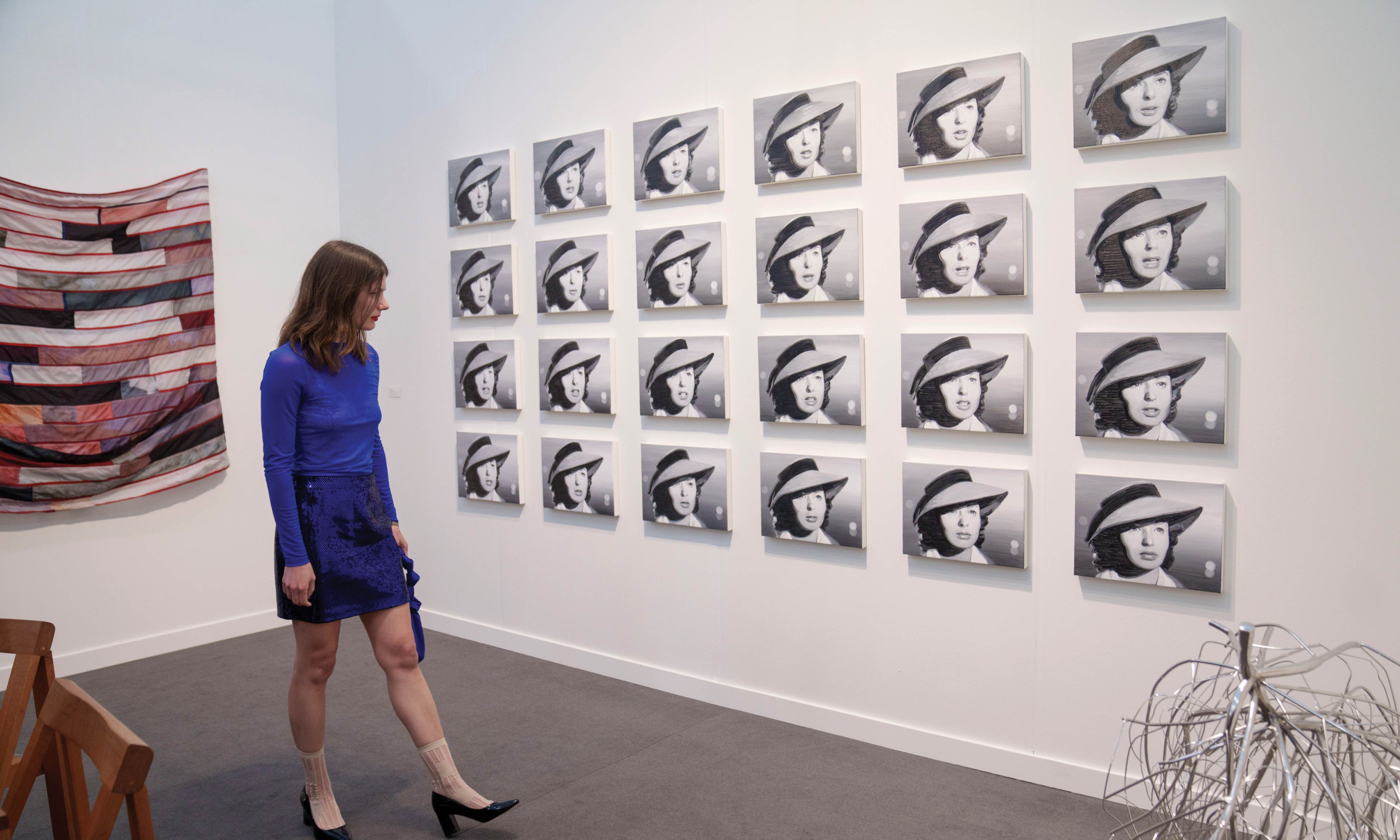Cynthia Daignault’s God Bless You (2024)—a grid of 24 paintings—sold for $120,000 at Night Gallery Eric Thayer
The fifth edition of Frieze Los Angeles has scaled down from the previous year, with 95 exhibitors underneath a single white tent set up on the grounds of Santa Monica Airport. Reports of seven-figure sales from the first, VIP-preview day also seemed to be down from last year, although many dealers said they were optimistic about the fair’s improved centralised layout.
The most expensive sale reported during Thursday’s VIP preview was by Gladstone Gallery, which placed a large-scale drawing by Richard Serra for $2m. Thaddaeus Ropac reported selling Robert Longo’s Untitled (Julien) (2016) for $1.6m, but the work on paper had been bought during an advance preview and was never actually displayed at the fair, a gallery representative said. Ropac also sold Anselm Kiefer’s painting Sag mir, wo die Blumen sind (2012-22) for €1.3m.
At Hauser & Wirth’s stand, an untitled 2010 painting by Ed Clark sold for $950,000, and Fishes, Wishes in Summertime Blue (2016) by Frank Bowling fetched $800,000. David Zwirner sold three paintings by Joe Bradley for between $300,000 and $450,000; two John McCracken sculptures for between $450,000 and $500,000; a Steven Shearer painting for $480,000; and a Huma Bhabha sculpture for $650,000. Perrotin sold a large-scale painting by Cristina BanBan in the range of $100,000 to $125,000.
All together now
Vielmetter sold Veduta (Vuillard Jardins Publics) (2023-24), a nine-canvas piece by the Los Angeles-based artist Whitney Bedford, for $300,000 to a collector based in Hong Kong who is opening a private institution. Gagosian sold Lauren Halsey’s sculpture watts happening (2024) to a leading museum in Los Angeles for an undisclosed price. Night Gallery sold Cynthia Daignault’s God Bless You (2024)—a grid of 24 paintings of Ingrid Bergman in the final scene of Casablanca—for $120,000.
Last year, Frieze Los Angeles hosted 124 galleries, with most housed in a tent while a smaller selection set up shop in the nearby Barker Hangar. The two separate spaces and the roughly ten-minute walk between them were the subject of criticism at the time, with some galleries in the hangar saying that they felt isolated from the rest of the fair. Christine Messineo, Frieze’s director for the Americas, says that the new layout is a response to the feedback last year.
“This feels very manageable. I was just talking to someone as we were walking through the fair, and they were like, ‘It’s a great size to spend time with the galleries, grab a quick bite and then come back in,’” Messineo says. While the number of exhibitors has been scaled down by around 20% from 2023, the fair has “a really strong local contingency, and we’ve actually seen growth in terms of galleries that are present”, Messineo says. Around 40% of galleries taking part have a space in the greater Los Angeles area, according to the organisers.
Los Angeles mainstay Anat Ebgi made the step up from the Focus section to the main part of the fair this year. The gallery made several sales in the fair’s opening hours, including the Los Angeles-based painter and sculptor Meeson Pae’s painting Seep (2024) for $38,000. Stefano di Paola, a partner and senior director at the gallery, said that this year’s more centralised layout has benefited both emerging and established galleries.
“It’s really nice to be able to consider all the galleries in a single space,” Di Paola says. “It doesn’t create this arbitrary hierarchy that might happen between a main versus the secondary space. It cements that all galleries are here together and we’re all a community under the Frieze banner.”
California galleries taking part in Frieze Los Angeles for the first time include Nazarian Curcio, which renamed itself just two weeks before the fair to reflect the growing partnership between the founder Shulamit Nazarian and co-owner Seth Curcio. The gallery is staging a solo stand dedicated to Widline Cadet, a Los Angeles-based Haitian artist whose work ranges from $3,000 to $45,000. The stand marks Cadet’s first solo presentation in Los Angeles, Curcio says.
Indigenous emergence
The Los Angeles-based Babst Gallery’s stand is dedicated to Harry Fonseca’s figurative paintings and drawings. The gallery opened this past summer with a show presenting the late California-born artist’s work. An enrolled citizen of the Shingle Springs Band of Miwok Indians, Fonseca’s colourful paintings draw on the traditional ceremonies of his tribe and other Indigenous groups.
“We’re so excited to show Harry’s work in a contemporary-art context,” says Helen Babst, a partner at the gallery. Prices on the stand range from $125,000 to $250,000, and the gallery made several sales in the first few hours of the VIP preview, she says.
Vielmetter, founded in Los Angeles in 2000, has taken part in every Frieze Los Angeles since the fair launched in 2019. Senior director Michael Smoler says that the local art market benefits from strong institutions and an abundance of artists living locally.
“Los Angeles is the Great West. It’s where anything can happen,” Smoler says. “Hollywood is here, and people who come out are creative. Most people are trying to pursue their dreams, whether that’s in acting or music or art, or even being an influencer.”

